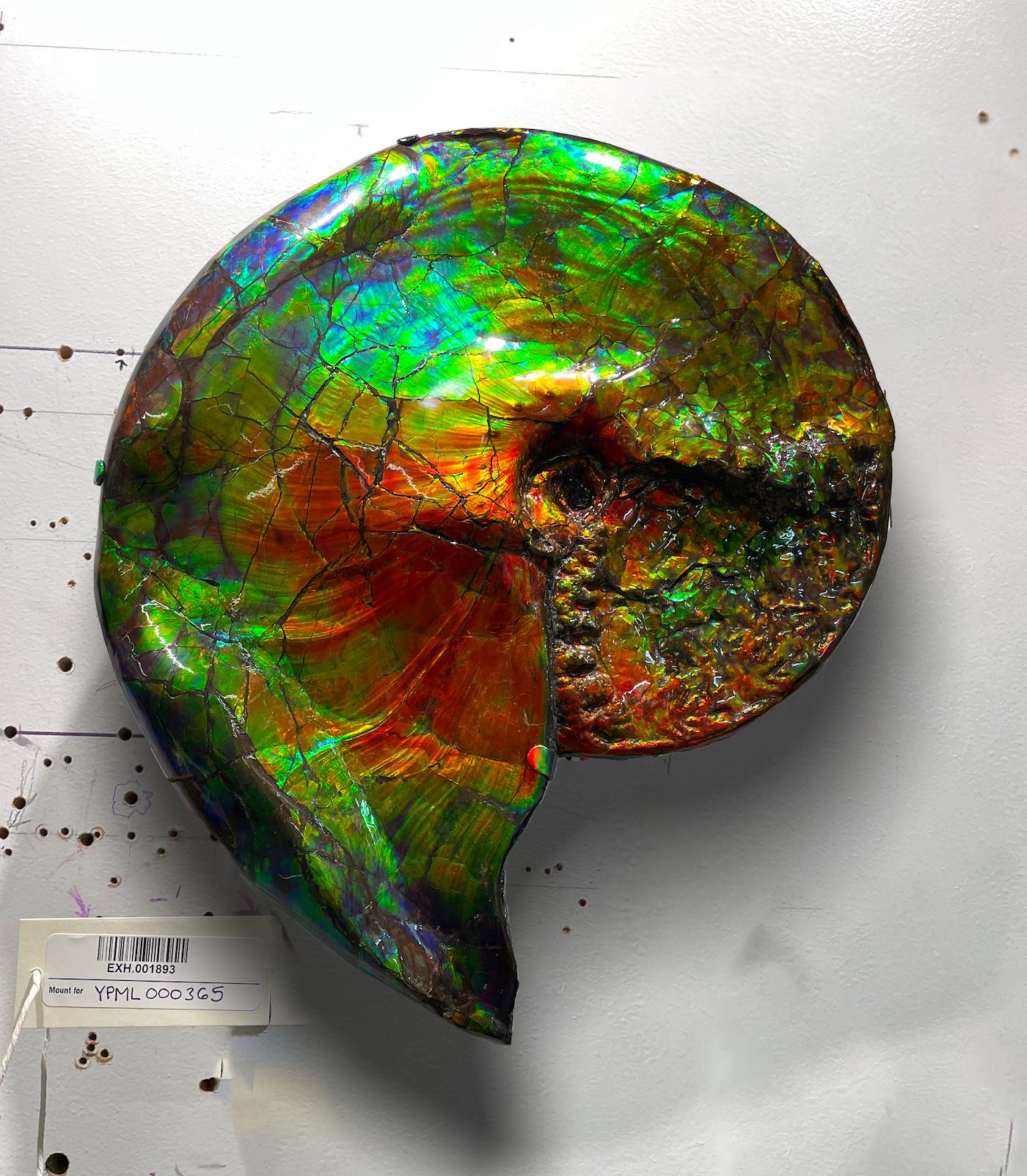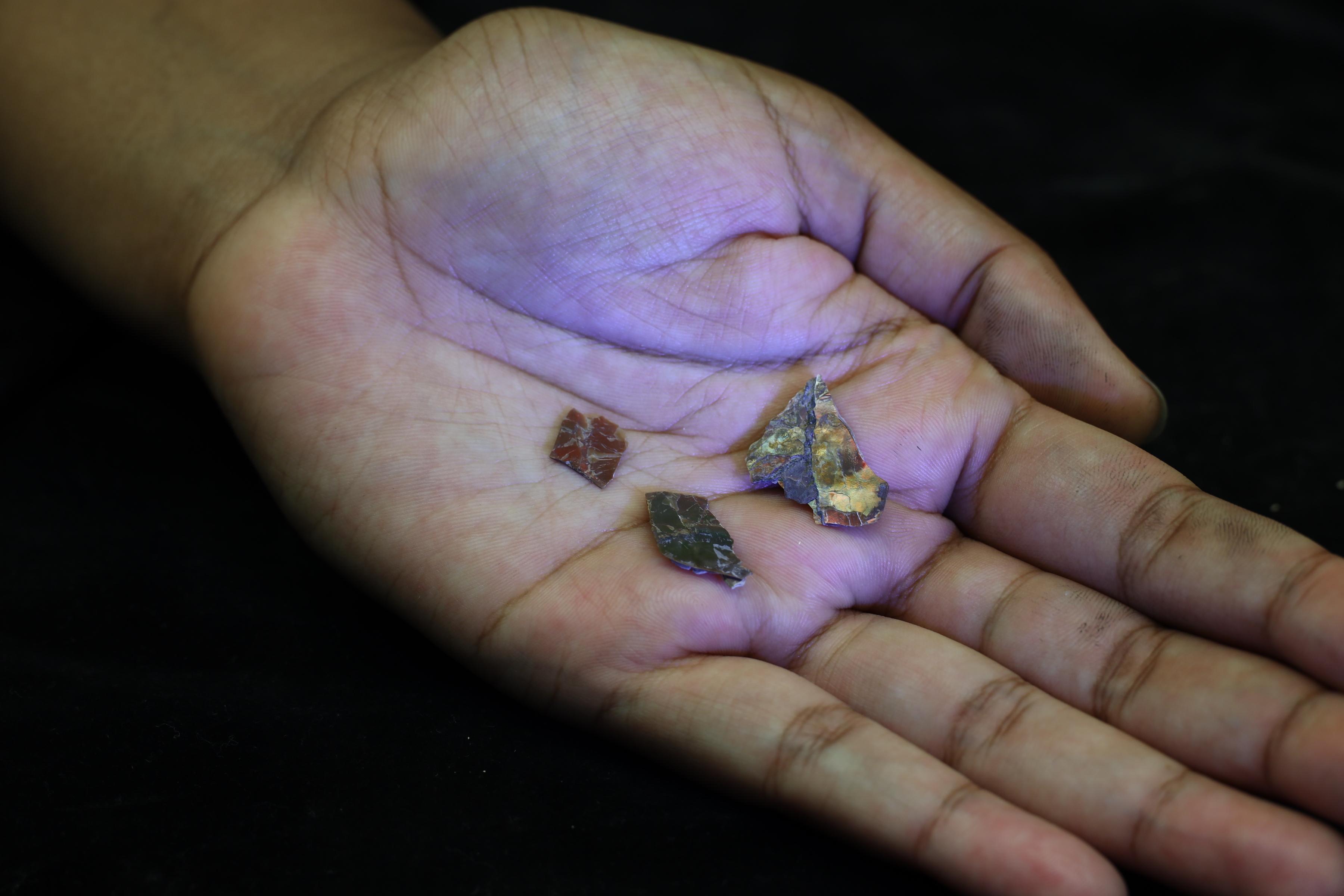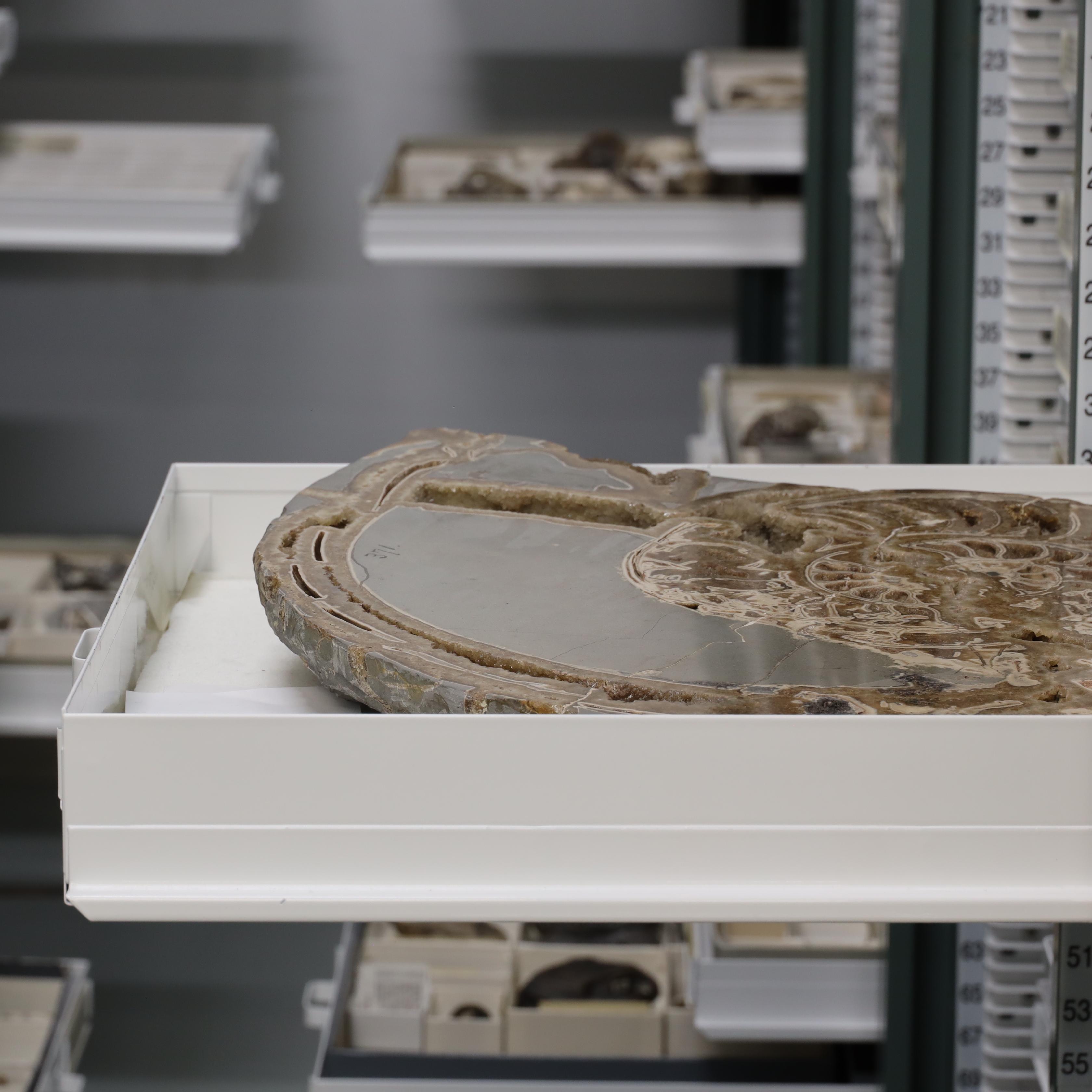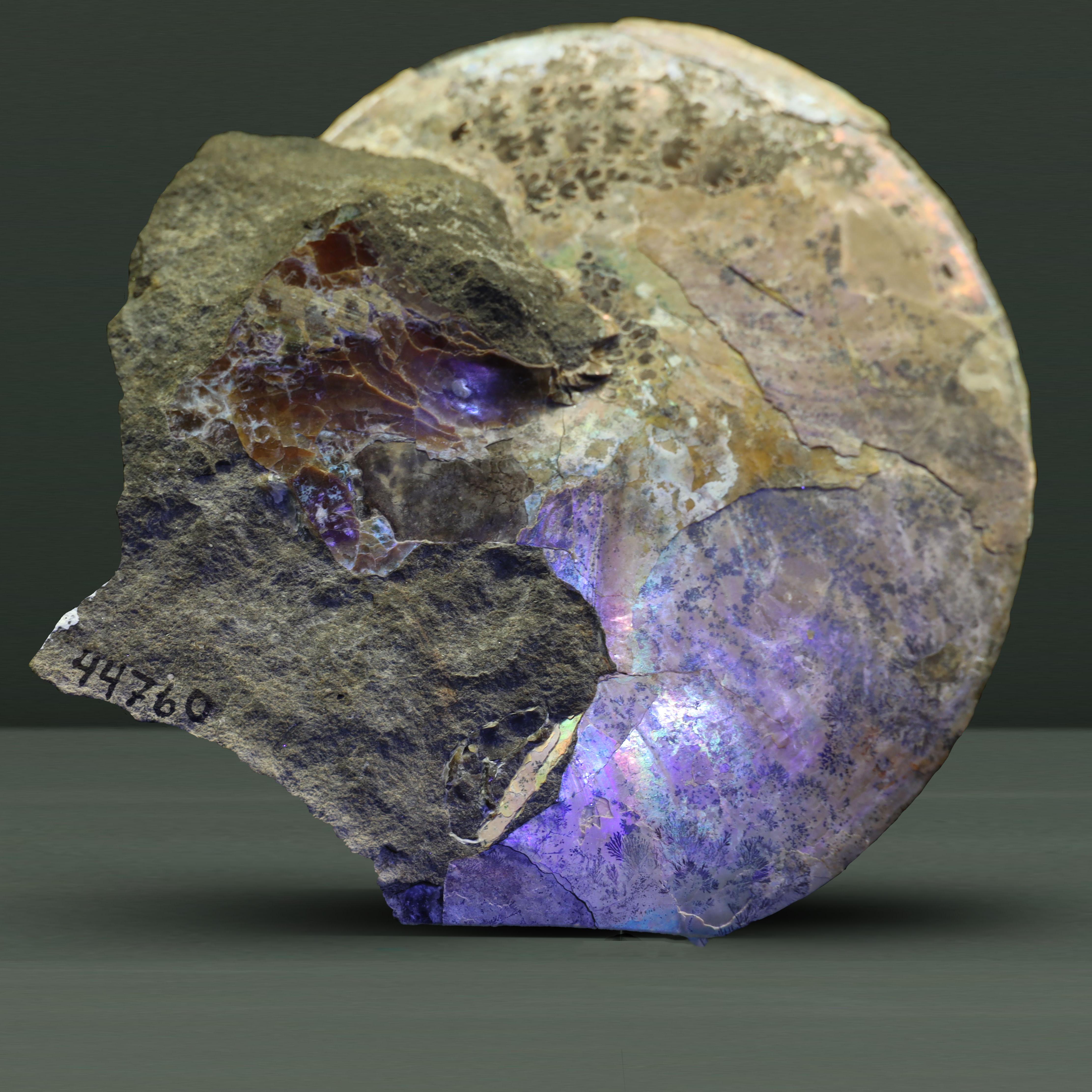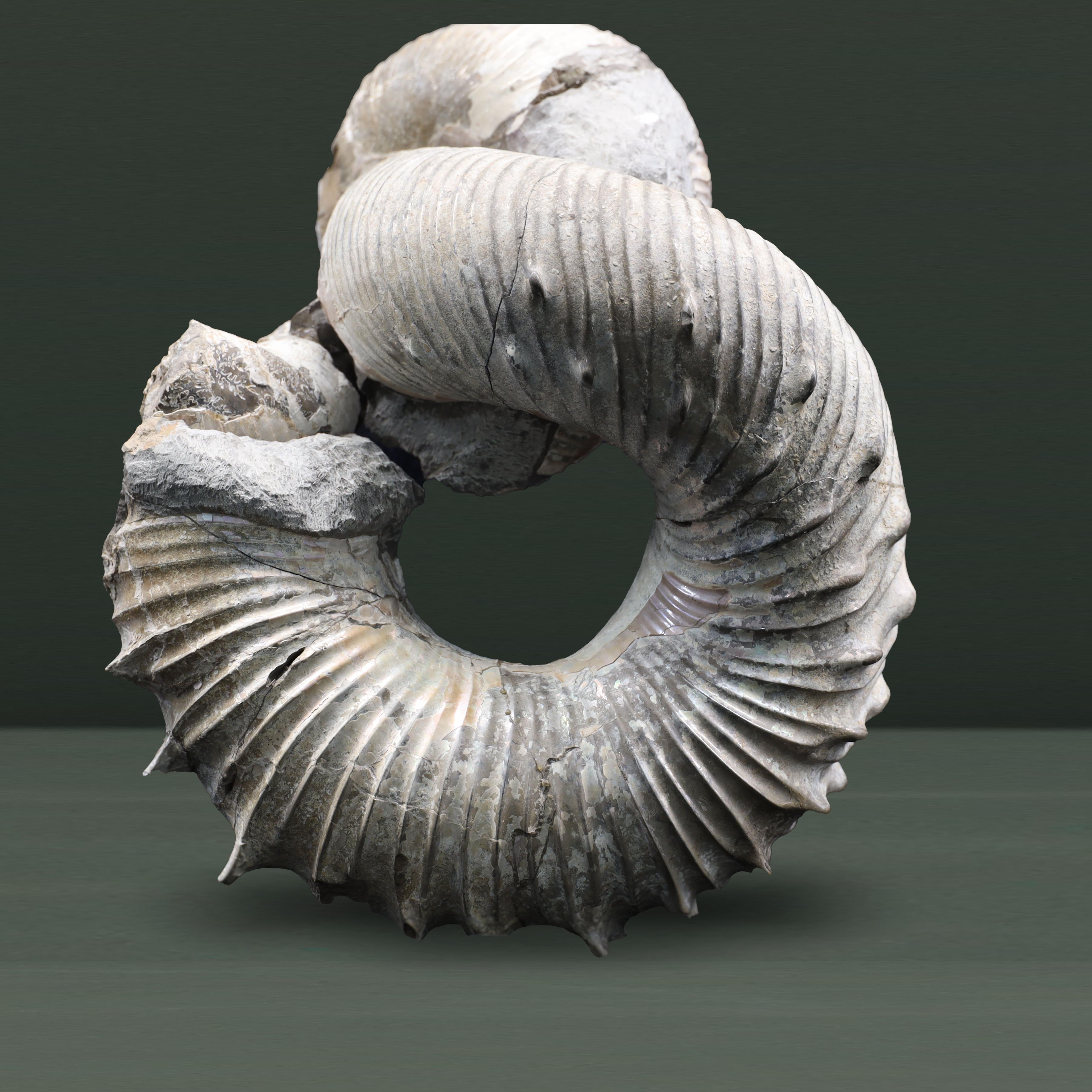“Fossils belong in the Paleontology collections.” That’s what Mineralogy & Meteoritics Collections Manager Stefan Nicolescu says when asked about the nearly two-foot long ammonite fossil we’re hovering over. Ironic, since we are still in the Mineralogy collection. But this is no ordinary ammonite—this is ammolite.
Ammolite is an iridescent (think shiny rainbow) gem material found on ammonite fossils. Ammonites were ocean-dwelling mollusks that lived from the mid-Devonian (388 million years ago) through the Cretaceous (66 million years ago). Their closest living relatives are coleoids (octopus, squid, and cuttlefish).
Ammolite is found almost exclusively in the Bearpaw Formation in Alberta, Canada. This 70- to 75-million-year-old Late Cretaceous geologic formation contains fossils from dinosaurs, plesiosaurs, mosasaurs, and even an ancient sea turtle. It also has an abundance of iridescent fossilized ammonites.
A relatively new gem (it was officially named in the 1960s), ammolite is one of the world’s rarest and most valuable gemstones. As Nicolescu explains, ammolite is a form of aragonite, the mineral that makes up the shells of ammonite fossils. To be officially named a mineral, a material must be a naturally occurring, uniform solid with a characteristic chemical composition and an ordered crystalline microstructure. Ammolite is identical in composition and structure to aragonite (both are calcium carbonate) and therefore is technically not a separate mineral. Naming practices for minerals don’t apply to gems. Because the gem is found on ammonite fossils, it was named ammolite.
“It’s all aragonite,” Stefan quips. “One just glows.”
So what gives aragonite this vivid glow? The short answer is a combination of temperature, pressure, and mineralization (and spending 70 million years underground). Although a mineral has a characteristic crystal structure, various environmental factors can dictate the pattern in which those crystals form. This internal pattern gives a mineral or gemstone a structural color. If you were to grind up ammolite, you’d be left with a pile of gray dust.
This particular ammolite–ammonite (say that 5 times fast!), on loan to the Yale Peabody Museum, will serve as the focal point at the entrance to the new Burke Hall of Dinosaurs. Just around the corner, the Ancient Oceans gallery highlights cousins to this glowing fossil—not for their color, but for the organisms that used to inhabit them.
Born with a small, single-chambered shell, an ammonite added rooms as it grew. Each room was separated by a wall, or septum, and all were connected by a small tube, the siphuncle. This tube distributed gas throughout the shell, allowing the ammonite to control its own buoyancy. Most shells were spiral-shaped, like a modern nautilus, but some had unique shapes.
There is also a pattern to how the walls connect to the outer shell. The pattern is unique to each species of ammonite.
“To classify a specimen, you trace the pattern,” explains Susan Butts, Director of Research & Collections, as she pulls out drawer after drawer of ammonite fossils in the Invertebrate Paleontology collections, “all the way around the fossil,” and points out indentations in one.
To build its shell, the organism created an inner layer of nacre (mother-of-pearl), a composite material made of aragonite and organic proteins. It is nacre that’s responsible for the iridescence of pearls, shells, and ammolite. Ammolite is merely nacre that has been subjected to a particular temperature and pressure over time.
So now the million dollar question: Is it a fossil or a mineral? Or a gem?
Yes.
All fossils are made up of minerals. All of the ammonite fossils above are simply varying formations of aragonite. What makes them fossils is what they're left by (living organisms), not what they're made of. So an ammonite fossil, color notwithstanding, is both a fossil and a mineral. Ammolite is a trade name created for the gem–the iridescent rainbow coating. What characterizes the material as ammolite is its visual properties—shine, color spectrum, opacity, brightness. The formation and occurrence of ammolite gems depends on the mineralization of ammonite fossils. The Museum’s ammolite-ammonite is an ammonite fossil (made of the mineral aragonite) with an ammolite coating. For its visual appearance, the Museum stores it with other gemstones.
When asked whether she has an opinion on the categorization of the specimen , Susan shrugs. “Not really.”
It’s in the Mineralogy collections because it’s a gemstone, but then everything we have here is also a mineral. It’s all the Museum.
— Susan Butts
The ammonites that will be on view, including our ammolite specimen, are prepared by museum technician Stefan Hurlburt (yes, another Stefan) and others in the mount team, who engineer and construct supports for a number of Peabody Museum displays.
Down in the Mount Lab, where mount assembly takes place, Stefan opens a box and pulls out what looks like a small black tripod. “Here’s an ammolite mount.”
If the small size (or simplicity) of the mount is surprising, know that it’s by design. “The less you can see our work,” Hurlburt says, “the better it is.” On closer inspection, the outer tabs are painted to blend in with the rainbow gem. The ammolite is covered in epoxy and so the surface will scratch easily. The rule of thumb, both for the mount and those building it, is to avoid contact with the specimen as much as possible. Luckily, mounting roundish objects like this large ammolite is fairly straightforward compared with more delicate or complex shapes. Because the ammolite will be tight against a wall, not much is needed to maintain its stability and safety.
Hurlburt’s no stranger to ammonites. “There are so many,” he chuckles. “I’ve done mounts for ones this small”—he makes a circle with his thumb and forefinger—“to this big!” and stretches his arms out wide, laughing. “That’s why I love this role. We see everything. We see the best of the best.”
While he’s not wrong, there are hundreds of thousands of objects and specimens he (and the visiting public) won’t see. Less than a tenth of 1% of the Peabody’s full collections can be displayed at one time. For ammonites alone, over 22,000 specimens are cataloged at the Museum. Objects that do go on display must represent not only the best of the Peabody’s collections, but the depth of information, research, preparation, and resources that goes into them.
Then again, a giant rainbow seashell by itself isn’t too shabby.
Come see ammolite, the ammonites, and all their fellow sea creatures at the grand reopening of the Yale Peabody Museum in early 2024.
